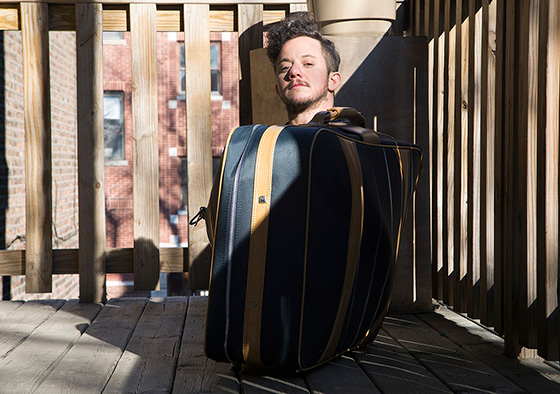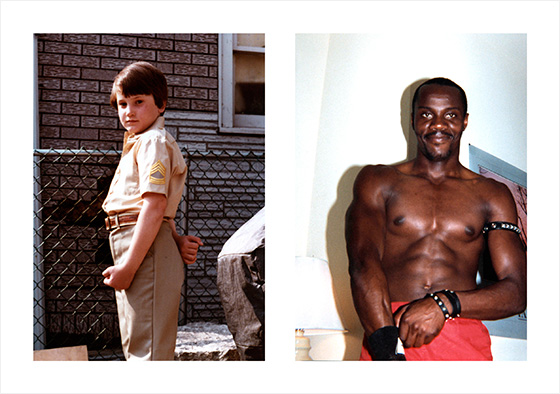| « A Painter's Voice: Portals, Passages and Vessels at Linda Warren Projects | Postcards from the Mess: Lillie West » |
Feature Mon Jun 09 2014
I Grew Up in a Big Ol' Gay Disco: an Interview with Oli Rodriguez
By H. Melt
Oli Rodriguez is an interdisciplinary artist working in film, photography, and performance. His art often queers notions of family, desire, and collaboration. I recently attended two of his exhibits, Love to Love You at Roots and Culture with Sara Condo and I want something more than my husband and my house with Jovencio de la Paz at Chicago Artists Coalition. His latest exhibition, The Human Space with Andy Karol, opened at Beauty & Brawn Art Gallery and Think Space this weekend. I sat down with him to find out more about his relationship to Chicago, the city's queer history, and how it impacts his artmaking.

Oli Rodriguez
You were born and raised in Chicago, right? In Humboldt Park specifically?
We moved around a lot but it was Humboldt Park first and then I moved to West Town, which didn't exist as West Town then. It was around the Grand section. I'm considering Grand Avenue as this invisible barrier where literally, it was like a racial line. So if you follow Grand, all the way west from Western to Harlem, there's this division that exists. It's a line of division with black folks south of Grand.
Grand is notoriously an industrial area. It's all of these large factory buildings, which are now converted into lofts. The neighborhood completely transformed. The block I lived on... it's gone. Every single house is gone. So the apartment I lived in, it's there, but it's surrounded by multi-million dollar homes. It was all empty lots when I was growing up.
I mostly grew up with working class families of color. There were a lot of mixed race families — Latino and white was the majority, which is interesting to think about considering the history of Humboldt Park and given the gentrification of Lincoln Park, which pushed most Latino folks west. I think about that a lot coming from a mixed race background and how the demographics of this particular neighborhood were so visual, so visible and so separated.
I built my own darkroom at 19. I dragged home this enlarger and built it in the basement on campus in the dorms. We had a themed house. It was GRRRL house. It was gender relations for real revolutionary living. We were this kind of pre-MTV archetype of young, queer, differently identified folks. It was DePaul so there was this whole rule of same sex living and this was early 2000s. We'd throw punk shows, we'd have organizations come in and provide programming to the school at large.
Is that the point at which you're beginning to develop some sort of queer identity?
Yeah, I definitely identified as queer at a really young age. Language like that was happening at 18, 19 and it helped.
How did you find that language initially?
It was in a math class. I was really good at math and this person came up to me and was like, "Hey, I saw you got an A on your test, can you help me study?" It was this slam poet, young person of color, and we started talking. When I met Kay, they introduced me to some of the classes they were taking and by my second semester, I took a gender studies class. I met one of my first trans friends there, who kind of outed me as trans at 19 and I was like "What? No!" Five years later...
What were some of the other queer spaces that you were going to?
I was going to the Fireside a lot at that age for punk shows. The Royale was an underage club, it was open for a very short amount of time. The bathrooms were like the most packed places, whether for drugs, sex or drinking. This all happened along Fullerton. The Royale was on the corner of Fullerton and Milwaukee and four blocks east was the Fireside Bowl, which I actually live around the corner from now, on Fullerton and Washtenaw. GRRRL house was at Fullerton and Racine. We had this one street that connected all of these different communities.
The Royale was all young POC folks. Fireside had a mix but there were a lot of folks, mostly white, from the suburbs. It was almost like this tier of moving west. DePaul was predominately white, academic. The Royale was almost 95 percent queer youth of color, it was more Chicago youth. There was this split happening that I often felt, where I had my Chicago POC folk and then I had DePaul or punk shows and the Fireside. There was quite a division that happened even though it was four blocks away from each other. This was Logan Square back in the late '90s, early 2000s, which is a very different space than it is now.
There was Horizons, which was like a BYC [Broadway Youth Center] before there was BYC. It was also off Fullerton and Sheffield and it was right under the train. It offered a space for queer youth to come once a week. That's where the Lesbian Avengers, when they were around, met. Even though it was called Lesbian Avengers, it was a really awesome genderqueer movement. There's this bar on North Avenue, No Exit, and we went to protest. Someone who was trans identified or gender nonconforming (we didn't have that language then) got bashed there.
Your art is often about your relationships to queer people and spaces in Chicago. Your family is also very present in your work. The Papi Project combines both of these elements by archiving your dad's history, who died of complications from AIDS in 1993, and your own history at the same time. What has it been like visiting some of his former cruising spaces to photograph them?
I grew up in gay bars and going to the Belmont Harbor and going to the rocks. The rocks used to exist where there were tiers, so there was more private space. I went to these cruising spaces, not knowing what they were and just riding my bike around. Actually I didn't have a bike, I would sit on his bike and ride the city. These cruising spaces aren't foreign, they're very familiar.

"The Papi Project: Archival Images #71 and 80: My Eagle Scout son and International Mr. Leather lover" by Oli Rodgriguez
It's this weird moment to go back to because I existed then as this genderqueer kid in primarily gay male spaces. It was kind of nice because I got to get out of my neighborhood, which is another very Chicago thing where maybe you don't ever leave your block. I got the opportunity to go to Lincoln Park, which I'd never been to.
There's this idea that if you're making queer work, it's going to be about sex. In I want something more than my husband and my house, there's this queering of desire, this queering of the audience's expectation of what a queer or trans desire looks like through your photographs.
The fetishized object is really important, as well as the fetishized person. In the photographs, I'm thinking about restraint with the suitcase, thinking about breath play, thinking about indigo and that history. I think it's important that there's this infusion of humor or absurdity or some sort of self consciousness. Each image is having its own internal dialogue. I want there to be a list of 10 or 15 questions or observations.
What are narratives, images, desires that you think are missing from queerness? Or that you would like to see more of?
I can tell you what I'm done seeing, I'm done with nudity for awhile, I'm done with the literal representation of my body is different, here's how it's different. It often becomes deduced down to queer sex. There's much more subtlety and nuance. What often happens is disregard, like, "Oh it's queer," I know exactly what that's going to look like. It becomes a stereotype of a queer show or a queer piece. I don't even know what a queer piece looks like, I hope I never know what it looks like, but I know by stereotyping, it's going to be some phallus, some strap-on or something leather. I want more of a multifaceted image.
When do we get past the queer or trans show?
Queer is often used interchangeably with gay in art shows. I really feel like it's based on who the curator is and who's pulling in what artists. If it's a show that is named queer and all of your artists are gay white men, it's not a queer show. Often times queer becomes this synonymous gay term and it's not.
I feel like it's important to have language that identifies a show and identifies artists. When I went to see 30 Americans, I came back and was having conversation around it. It's a similar conversation, but not the same. Why is it, that when a particular marginalized population is brought together, why is it in opposition or why is it a certain type of show rather than just being an art show? I think it's just reinforcing this whole heteronormativity or this whole idea of whiteness as the norm.

"The Papi Project:Public Cruising Spot #13, Belmont Harbor, Chicago, Illinois" by Oli Rodriguez
How do you build a community of artists who are denied access to the larger art world, while not marginalizing yourself?
I don't have the answer to that. We still have this moment of they're a queer artist and the whole range of things that happen after that is said. We inherently do this association game. I apply to queer shows or shows that emphasize queerness or transness. I think it's important to show in these shows and important to build that community.
I think that's also when collaborations with allies are important. Making these connections to folks who may be part of this other world or the art world, whatever that means. If it's African American art or queer art it has this illegitimacy. The expectation is that it's not enough or somehow needs to be classified because it's not just art, it's a certain kind of art. That becomes problematic because then it can't just exist as art. I struggle with that because of the idea of empowerment and wanting to name it and be a part of this community and also wanting to exist not just within a certain community or bubble because we live in a straight world.
~*~
The Human Space, photographs by Andy Karol and Oli Rodriguez, appears at Beauty & Brawn Art Gallery and Think Space, 3501 W. Fullerton Ave. The show runs through July 26. Karol and Rodriguez talk about the exhibition on Sunday, June 29 at 6pm.
H. Melt is a poet and artist who was born in Chicago. Their work proudly documents Chicago's queer and trans communities. H. Melt has been published by 3rd Language, Original Plumbing, and THEM, the first trans literary journal in the United States. They are the author of SIRvival in the Second City: Transqueer Chicago Poems.








